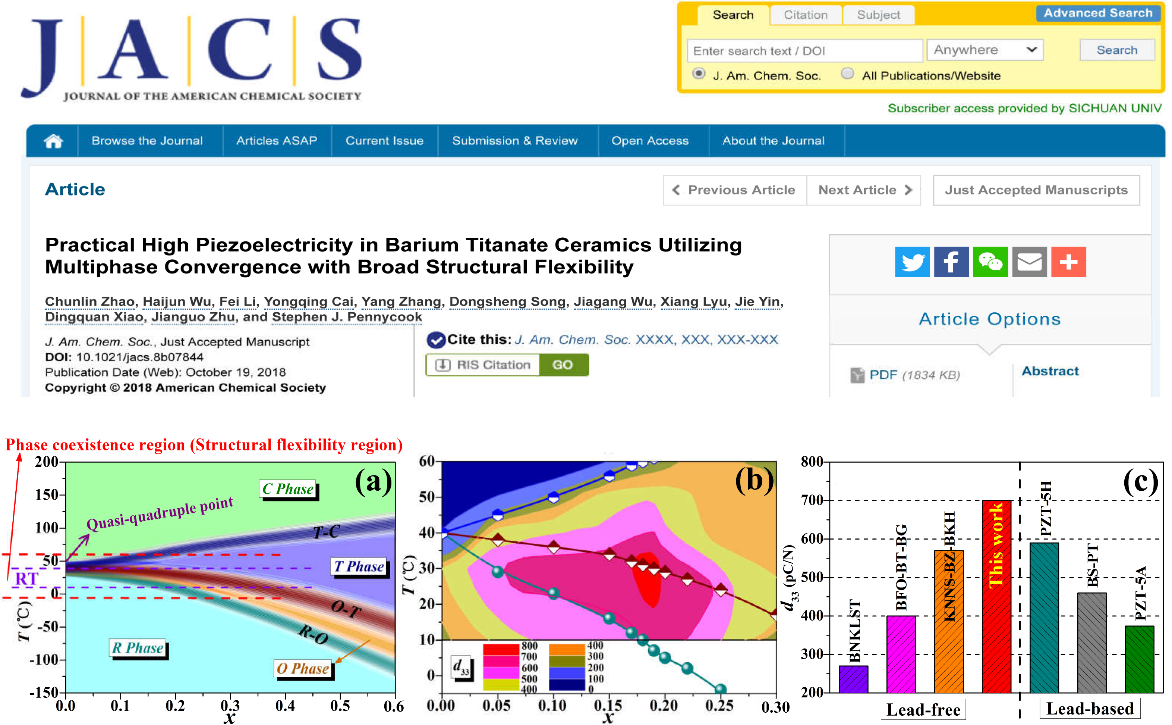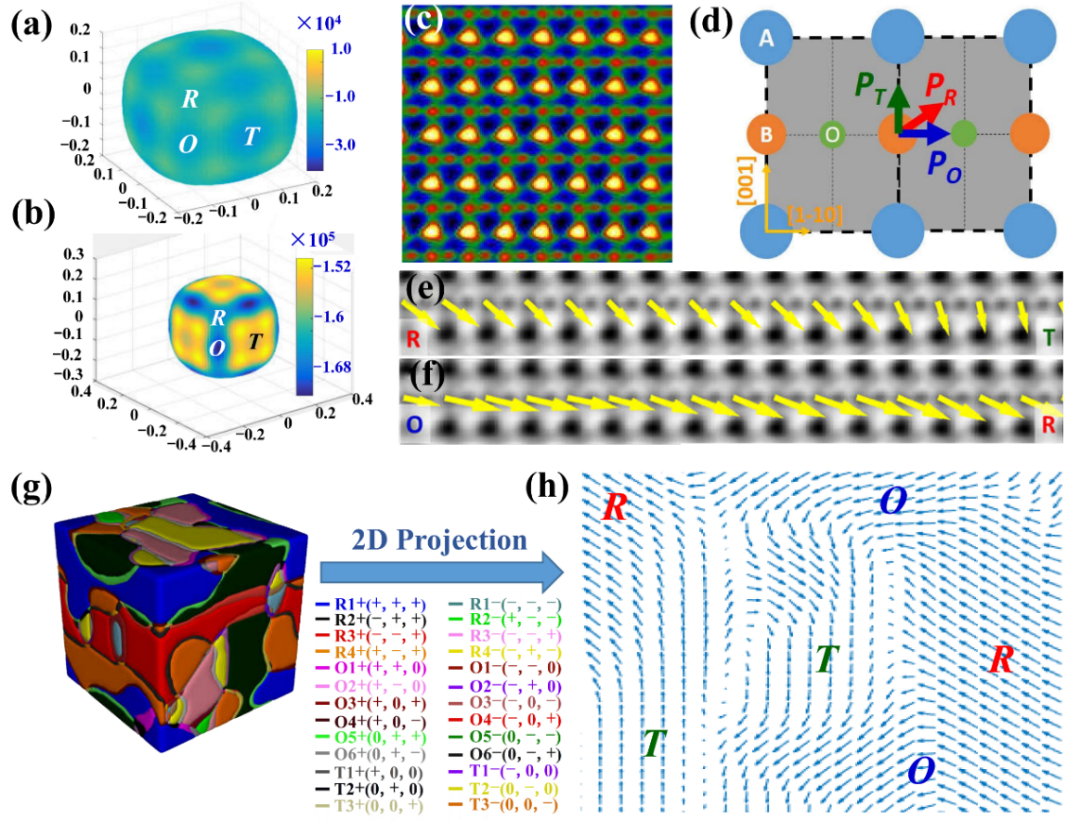Recently, an international team led by Prof. Jiagang Wu (Sichuan University), Prof. Stephen J. Pennycook and Mr. Haijun Wu (National University of Singapore) has made a significant progress regarding the development of piezoelectric enhancement and physical mechanism study of lead-free BaTiO3-based piezoceramics. This work has been published in an article entitled “Practical High Piezoelectricity in Barium Titanate Ceramics Utilizing Multiphase Convergence with Broad Structural Flexibility” in Journal of the American Chemical Society (IF=14.357).This research is a cooperative project with Department of Materials Science and Engineering, National University of Singapore;Singapore Department of Materials Science and Engineering, Materials Research Institute, and Pennsylvania State University. The first author is Chunlin Zhao who is a doctoral student at Sichuan University. Professor Jiagang Wu is one of the corresponding author, and Sichuan University is the first work unit on the research paper.
Piezoelectric materials enable the transformation between electrical and mechanical energy and can thus be used in actuators, sensors and transducers. Until now, Pb (Zr, Ti)O3(PZT)-based ceramics are the most widely used piezoelectric materials because of high piezoelectricity. Because of global environmental concerns on lead toxicity and the new Restriction of Hazardous Substances (RoHS) legislations which prohibit lead-based piezoelectric materials in 2020, lead-free alternatives are urgently needed. However, no material has been able to reach competitive performance at this point. BaTiO3piezoceramics is one of the most promising candidates, while its piezoelectric coefficient (d33) is relatively low (~190 pC/N). Previously, high piezoelectric constant has been achieved in BaTiO3-based ceramics through the construction of rhombohedral-tetragonal (R-T) phase boundary, starting from a tri-critical point. However, this optimizedd33can only be achieved within a narrow composition/temperature region. In this work,the authors employanovel phase-boundary strategyutilizingthe “quasi-quadruple point”, which induces a broad structural flexibility in a wide phase-boundary zone withcontiguous polymorphic phasetransitions, from R to orthorhombic (O), then to T phase [Fig. 1(a)]. In addition, the physical mechanism for enhanced performance has been clearly addressed. Ultrahigh piezoelectric constant (d33~600-700 pC/N) can be achieved in BaTiO3-based ceramics over a wide composition range[Fig. 1(b)], which exceeds the performance of the majority of lead-based systems[Fig. 1(c)].

Figure 1. (a) Schematic showing phase coexistence regimes based on the phase diagram. (b) Contour mapof piezoelectric coefficientd33in temperature-composition plane for this work. (c) Comparison of the reported largestd33among lead-free piezoceramics, and typical PZT ceramics.
The structural/physical origin is shown to be due to gradual polarization rotation between coexisting phases with low energy barriers and polarization anisotropy. Landau free energy modeling confirms the low polarization anisotropy between R, O, and T phase[Figs. 2(a) and (b)]. Atomic-resolution polarization mapping by Z-contrast imaging reveals the coexistence of three ferroelectric phases (T+O+R) at the nanoscale with nanoscale polarization rotation between them[Figs. 2(c)-(f)], which is also verified by the results of phase-field simulations[Figs. 2(g) and (h)]. Theories and experiments support the generation of the broad composition range of phase coexistence (structural flexibility) with much reduced polarization anisotropy, which is the origin of this superior performance.This work offers a new paradigm for designing lead-free piezoelectric materials with superior electromechanical properties. It is reasonable to believe that this result represents a significant step towards replacing toxic lead-based compounds.

Figure 2. Free-energy profiles for this system (BTS0.11-xBCT) with (a) multiphase (T+O+R+C) convergence atx= 0 and 40 °C and (b) three phase coexistence (T+O+R) atx= 0.18 and 25 °C. (c) Contrast-inverted STEM ABF lattice image. (d) Schematic projection of the ABO3unit cell along the [110] zone axis, polarization directions for T, O and R phases are marked accordingly. (e) Enlarged image showing gradual polarization rotation from R to T phase. (f) Enlarged image showing gradual polarization rotation from O to R phase. (g) Phase-field simulations of T+O+R three phases coexistence in BTS0.11-xBCT ceramics withx= 0~0.2, and (h) their projection of polarization on the (110) plane.
Journal of the American Chemical Society (JACS), founded in 1879, isone of the most influential academic journals in chemistry. It is the first time that JACS publishes an article about the development of piezoelectric enhancement and physical mechanism study of lead-free BaTiO3-based piezoelectric ceramics. Until now, JACS has published only four research papers about perovskite lead-free piezoelectric ceramics with high piezoelectricity, and three of them are attributed to Prof. Jiagang Wu's research team.
To read the article, please go to the link below:https://pubs.acs.org/doi/10.1021/jacs.8b07844
Authors gratefully acknowledge the support of the National Science Foundation of China (51722208 and 51332003).
